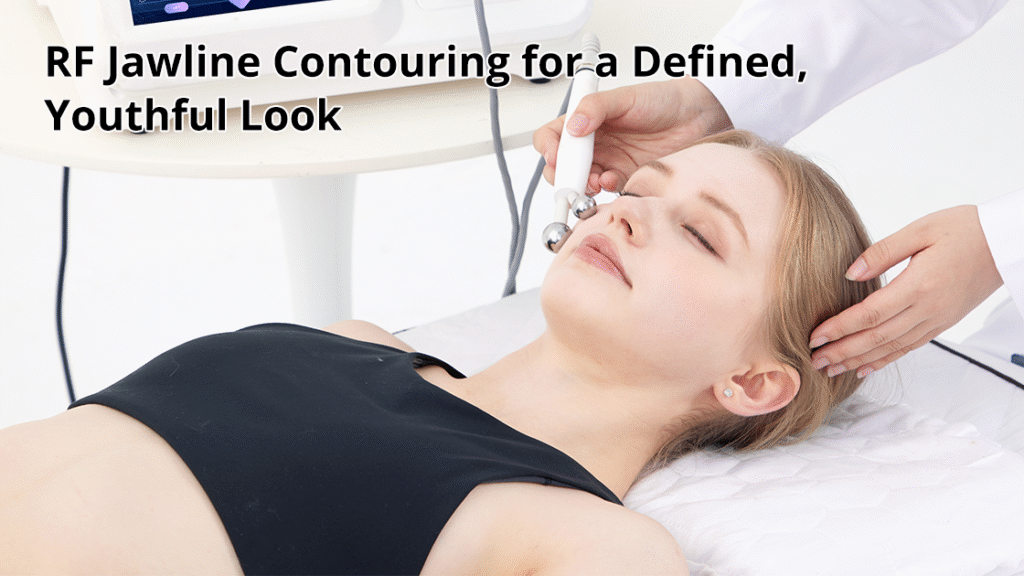A defined jawline is a symbol of youth and beauty, often associated with strength and facial symmetry. In today’s world, more people are seeking non-surgical treatments that offer a natural and long-lasting way to sculpt and enhance their jawline. Radio Frequency (RF) technology is leading the charge in non-invasive contouring, providing a safe and effective solution for those who want a sharp, youthful jawline without undergoing invasive procedures like surgery or fillers. In this blog, we will explore how RF technology works to sculpt your perfect jawline, the benefits it offers, and how it compares to other treatments.
1. Introduction: The Quest for the Perfect Jawline
A chiseled jawline has long been a symbol of attractiveness and youth. As we age, however, skin loses its elasticity, and fat can accumulate around the chin and jaw, leading to a less defined jawline. This is where treatments like RF come in, offering a non-invasive solution to restore a sharp and youthful jawline.
1.1 Why a Defined Jawline Matters
The jawline is one of the key features that define facial symmetry. A sharp, well-defined jawline can balance the proportions of the face, enhancing the overall aesthetic appeal. Symmetry is often subconsciously linked to attractiveness, and a defined jawline enhances this feature. A defined jawline is often associated with youth, vitality, and strength. Many people choose to contour their jawline to reverse signs of aging, such as sagging skin, or to enhance their natural features for a more balanced appearance. As we age, collagen and elastin production decrease, leading to skin laxity. A sagging jawline can result in a tired or aged appearance. Non-surgical procedures like RF help stimulate collagen production, tightening the skin and restoring the youthful firmness of the jawline.
1.2 The Evolution of Jawline Sculpting
Traditional jawline sculpting methods often involved invasive surgeries like facelifts or liposuction, which required long recovery times and came with certain risks. Over the years, however, the demand for less invasive treatments has led to the development of non-surgical options, such as RF, Botox, and dermal fillers, all of which promise effective results with minimal downtime. Radio Frequency technology has emerged as a non-invasive, safe, and effective treatment to tighten skin, stimulate collagen production, and enhance the jawline contour. RF provides a gradual, natural result, with no need for surgery or injections. With advancements in RF technology, there are now more precise devices available, offering highly customizable treatments to target different areas of the jawline for optimal results. The future of jawline sculpting lies in these non-surgical technologies, which continue to evolve with improved effectiveness and shorter treatment times.
2. What Makes RF Different from Other Contouring Treatments?
RF technology offers a distinct approach to jawline contouring that sets it apart from other popular treatments like Botox, dermal fillers, liposuction, and ultrasound. Here’s a closer look at how RF compares to these treatments.
2.1 RF vs. Botox: Comparing Effectiveness and Longevity
Botox works by relaxing the muscles in specific areas of the face, which helps reduce dynamic wrinkles (such as frown lines and crow’s feet). However, Botox doesn’t target the skin or address laxity or volume loss. RF, on the other hand, targets the dermis to stimulate collagen production and tighten the skin, providing a more sculpted jawline. Botox results typically last for 3 to 6 months, requiring touch-ups to maintain the effect. In contrast, RF promotes long-term collagen remodeling, and results typically last 6-12 months or longer, depending on individual factors. RF provides a more sustainable solution for those seeking longer-lasting jawline definition. Botox doesn’t sculpt the jawline; it can help relax muscles and smooth wrinkles but doesn’t have the ability to tighten skin or reduce sagging. RF, however, works specifically to tighten the skin around the jawline and stimulate collagen, enhancing its contour and firmness.
2.2 RF vs. Dermal Fillers: Which Is Better for Jawline Contouring?
Dermal fillers add volume to specific areas of the face to create a more defined contour. While they can be effective for creating a more pronounced jawline, they don’t address the underlying skin laxity. RF, on the other hand, improves skin texture and tightens the skin, leading to a more natural and long-lasting result. Dermal fillers involve multiple injections, which can cause discomfort, bruising, or swelling, and require regular maintenance. RF is a non-invasive treatment that doesn’t require needles and has minimal recovery time, making it a more convenient and comfortable option for many. Dermal fillers may need to be replenished every 6-12 months, whereas RF provides a longer-lasting effect by stimulating the body’s natural collagen production, which helps maintain the jawline’s definition over time.
2.3 RF vs. Liposuction: Non-Surgical Jawline Contouring
Liposuction is a surgical procedure that involves removing fat from specific areas of the body, including the jawline. It comes with significant recovery time, risks of infection, and possible scarring. RF is a non-invasive procedure that requires no downtime, allowing patients to resume normal activities immediately. Liposuction removes fat to create a more defined contour, but it doesn’t address skin tightening. RF, on the other hand, targets the skin directly, tightening and firming it while also reducing fat in the treated area, providing a more comprehensive solution. RF is a safe, non-invasive treatment with minimal side effects, while liposuction carries higher risks due to its invasive nature, including anesthesia-related complications, infections, and scarring.
2.4 RF vs. Ultrasound Technology: Similarities and Differences
RF works by delivering controlled heat to the deeper layers of the skin to stimulate collagen production and tighten the skin. Ultrasound technology uses sound waves to penetrate the skin and break down fat cells, which is more effective for fat reduction than for skin tightening. RF targets the dermal layer of the skin, tightening and stimulating collagen production, while ultrasound works on fat cells deeper in the tissue. RF is better suited for improving skin tone and jawline definition, while ultrasound is primarily used for fat reduction. RF allows for more precise treatment of the jawline, while ultrasound is a broader technique. RF can target specific areas with greater accuracy, making it more effective for jawline sculpting.
3. How RF Targets the Jawline
Radio Frequency (RF) technology has become a revolutionary tool for jawline contouring, providing a non-invasive way to tighten skin, reduce fat, and stimulate collagen production. Below, we explore how RF specifically targets the jawline and delivers noticeable improvements.

3.1 Stimulating Collagen Production for Firmer Skin
RF energy works by emitting high-frequency waves that penetrate the dermis, the deeper layer of skin. This energy causes collagen fibers to contract, which triggers a healing response that stimulates the production of new collagen and elastin. As a result, the skin becomes firmer, more youthful, and more defined. Unlike other treatments that provide temporary results, RF’s collagen stimulation continues to improve over time. With each session, new collagen strengthens the skin’s structure, leading to a long-lasting effect. The jawline gradually becomes firmer, and the skin gains a natural lift. Studies have shown that RF treatments lead to noticeable improvements in skin texture, firmness, and elasticity. This makes RF an excellent option for individuals looking to achieve a more defined jawline without invasive procedures.
3.2 Tightening Skin and Enhancing Contour
The primary action of RF on the jawline is tightening the skin. By heating the collagen-rich layers of the dermis, RF encourages tissue contraction. This skin tightening effect reduces sagging and lifts the jawline, creating a more sculpted and youthful appearance. RF works by specifically targeting areas around the jawline that may have begun to sag due to aging or other factors. As the skin tightens, the jawline becomes more defined, leading to a sharper, smoother profile. This is particularly effective for individuals looking to enhance their jawline without adding volume. One of RF’s key benefits is its ability to contour the jawline without needles or incisions. This non-invasive method allows for precise tightening of the skin to enhance natural facial features, providing a youthful contour with minimal risk and downtime.
3.3 RF’s Role in Fat Reduction for a Sharper Jawline
RF energy also helps reduce subcutaneous fat, particularly around the chin and jaw area. As the RF waves penetrate the skin, they create heat that disrupts fat cells, causing them to break down and be naturally eliminated by the body. This fat reduction results in a slimmer, more contoured jawline. RF works in tandem to both tighten the skin and reduce fat, leading to a more refined and youthful jawline. The combination of these effects is why RF is so effective in providing a natural, sculpted jawline without the need for invasive fat removal methods like liposuction. Unlike drastic fat-removal procedures, RF’s fat reduction is gradual, ensuring that the results look natural. The fat reduction process is non-invasive, meaning there is no need for anesthesia, and the risk of complications is minimal.
4. The Treatment Process
RF jawline sculpting is a simple and effective treatment that provides long-lasting results. Let’s break down what happens during the treatment, how many sessions are typically required, and how to prepare for your session.

4.1 What Happens During an RF Jawline Treatment?
Before the treatment, the area around your jawline is cleansed to remove dirt, oils, and makeup. A thin layer of conductive gel is then applied to the skin to allow for smooth energy transmission from the RF device to the skin. The practitioner will use a handheld RF device to deliver targeted energy to the jawline. The device will be moved in gentle circular or linear motions along the jaw and neck areas. The energy penetrates the skin to stimulate collagen production and tighten the skin. During the procedure, you may feel a warming or tingling sensation as the RF energy penetrates the skin. The treatment is generally well-tolerated, with minimal discomfort. An RF jawline sculpting session typically lasts between 20 and 40 minutes, depending on the area being treated. There is no downtime, and you can return to your normal activities immediately after the session.
4.2 How Many Sessions Are Needed for Best Results?
For optimal results, most patients require 3-5 RF sessions, spaced about 1-2 weeks apart. This allows enough time for collagen production and skin tightening to take effect. As RF works gradually, results will continue to improve over time, with visible skin tightening and jawline definition appearing after a few sessions. The results become more noticeable in the weeks following the treatment, as the body produces new collagen and elastin. After completing the initial treatment series, maintenance sessions may be recommended every 6 to 12 months to sustain the results and keep the jawline looking firm and youthful.
4.3 How to Prepare for Your RF Jawline Sculpting Session
The first step in preparing for RF jawline contouring is scheduling a consultation with a trained practitioner. During this consultation, you will discuss your goals, medical history, and whether RF is the best treatment option for you. In the days leading up to the treatment, avoid excessive sun exposure and any skincare products that may irritate the skin (e.g., retinoids). You should also avoid taking blood-thinning medications or supplements, as they may increase the risk of bruising. After the session, you may experience slight redness or warmth in the treated area, but these effects typically subside within a few hours. No special aftercare is required, but it’s important to keep the skin moisturized and protected from the sun.
5. Post-Treatment Care and Maintenance
To achieve the best results and maintain the sculpted jawline, it’s important to follow a proper post-treatment care plan. Here are some essential tips for maintaining your results after RF jawline contouring.
5.1 Maintaining Your Sculpted Jawline After RF Treatment
- Hydration and Moisturization: Keeping your skin hydrated helps support collagen production and ensures the best results from RF treatments. Use a gentle, hydrating moisturizer to lock in moisture.
- Sun Protection: Protect your skin from UV damage by using a broad-spectrum sunscreen with at least SPF 30. This will prevent sun damage and premature aging, which can affect the results of RF treatments.
- Avoid Harsh Products: After treatment, avoid harsh exfoliants or any products that might irritate the skin for a few days. Stick to a simple, gentle skincare routine to allow your skin to heal and recover.
5.2 Diet and Exercise: Complementing Your RF Jawline Sculpting
- Healthy Eating: Eating a balanced diet rich in collagen-boosting nutrients like vitamin C and omega-3 fatty acids can help enhance the skin’s elasticity and support the collagen production stimulated by RF treatments.
- Jawline Exercises: Incorporate jawline exercises that strengthen the muscles around your face, such as chin lifts or jaw clenches. These exercises can improve the definition of your jawline and complement the results of RF.
- Maintain a Healthy Weight: Staying at a healthy weight can help maintain a sharp jawline, as excessive weight gain can lead to fat accumulation around the chin and neck.
5.3 Avoiding Common Pitfalls in Jawline Contouring
To see the best results, it’s essential to follow the recommended treatment plan and avoid skipping sessions. Consistent treatments help to achieve optimal tightening and contouring of the jawline. While RF is safe and effective, over-treatment can lead to unnecessary irritation or discomfort. Always follow your practitioner’s guidelines regarding the number of treatments. Skipping post-treatment care, such as sun protection and hydration, can hinder the results. Make sure to adhere to the recommended aftercare regimen to maintain a sculpted jawline.
6. User Testimonials
Hearing from individuals who have undergone RF jawline contouring provides insight into the treatment’s effectiveness, comfort, and real-world results. Testimonials offer a personal touch and help potential clients understand what they can expect from the procedure.
6.1 Success Stories and Before/After Results
Sarah, a 38-year-old from New York, had struggled with a softening jawline due to age-related skin laxity. After a series of 4 RF treatments, Sarah noticed a significant reduction in sagging around her jaw and neck area. “The results were subtle yet impactful,” Sarah says, “my jawline looks sharper and more defined. Friends and family keep asking me if I’ve had a facelift, but I haven’t!” Before and after photos of Sarah’s treatment show an evident improvement in the definition of her jawline. Her before photo shows slight sagging along the jaw and neck, while the after photo highlights the firm, youthful contour she now enjoys.
Another Patient Story: John, a 45-year-old executive, wanted to improve his jawline’s definition without resorting to invasive surgery. After just 3 RF sessions, his jawline appeared significantly more sculpted. “I wasn’t expecting such a noticeable change,” John says, “It’s subtle, but I feel more confident, and my face looks fresher.” His transformation was evident in both his appearance and self-esteem. He now recommends RF to his colleagues who are considering jawline enhancements.

6.2 Common Experiences from Users
Most patients report that RF treatments are relatively comfortable, with only mild sensations of warmth or a tingling feeling during the procedure. This contrasts with more invasive treatments like dermal fillers or liposuction, which often involve more discomfort or recovery time. Patients typically experience no downtime and can immediately return to their usual activities. A key benefit that many users point out is the minimal risk of side effects. While some may experience mild redness or swelling right after the treatment, these effects typically subside within a few hours. Users appreciate that there are no needles or invasive procedures involved, making it an appealing option for those wary of more intense treatments.
7. Summary
RF (Radio Frequency) jawline contouring is a non-invasive treatment that works by stimulating collagen production and tightening the skin to create a more defined, youthful jawline. This procedure not only reduces sagging but also addresses skin laxity and fat around the jawline. Compared to other treatments like Botox and dermal fillers, RF offers longer-lasting results with minimal downtime and no need for surgery. It’s a customizable treatment that provides gradual, natural-looking improvements, making it ideal for those seeking a non-surgical solution for jawline enhancement.
8. FAQs
Q1. How many RF sessions will I need for noticeable results?
Most patients typically need 3-5 sessions, spaced 1-2 weeks apart, to achieve noticeable results. The number of sessions depends on individual skin conditions and desired outcomes.
Q2. How long will it take to see results?
Initial improvements can be seen within 2-3 weeks after the first treatment, with continued results over the following months as collagen production progresses.
Q3. Is RF suitable for all skin types?
Yes, RF treatments are safe for all skin types. The energy levels can be adjusted to suit different skin tones and concerns, ensuring optimal results for everyone.
Q4. Are there any side effects?
RF is a low-risk procedure. The most common side effects are mild redness or swelling, which typically resolve within a few hours. There is no risk of scarring or severe complications.
Q5. Can RF treat both the jawline and neck?
Yes, RF is effective for both the jawline and neck areas. It tightens and firms the skin, improving the contour of the lower face and neck.
Q6. How should I prepare for my RF session?
Before treatment, it’s recommended to avoid sun exposure and certain skincare products (like retinoids) for a few days. A consultation with your practitioner will help determine your specific needs.
9. References
Radiofrequency facial rejuvenation: Evidence-based effect:
https://www.sciencedirect.com/science/article/abs/pii/S0190962210007607
Radiofrequency in Facial Rejuvenation:








